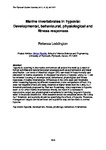Marine invertebrates in hypoxia: Developmental, behavioural, physiological and fitness responses
| dc.contributor.author | Loddington, R. | |
| dc.date.accessioned | 2019-05-15T09:37:50Z | |
| dc.date.available | 2019-05-15T09:37:50Z | |
| dc.date.issued | 2011 | |
| dc.identifier.citation |
Loddington, R. (2011) 'Marine invertebrates in hypoxia: Developmental, behavioural, physiological and fitness responses', The Plymouth Student Scientist, 4(2), p. 267-277. | en_US |
| dc.identifier.issn | 1754-2383 | |
| dc.identifier.uri | http://hdl.handle.net/10026.1/13960 | |
| dc.description.abstract |
Hypoxia is occurring in the marine environment all around the world as a result of human activities and natural biological processes such as eutrophication and water stratification. Low levels of dissolved oxygen (DO) can result in mass mortality and disruption for marine organisms. In this paper the effects of hypoxia (<5mg O2 l -1 ) will be reviewed focusing on developmental, behavioural, physiological and fitness responses of marine invertebrates. Differences in the units used and thresholds when measuring hypoxia, by different researchers, make comparisons difficult. It is clear that negative effects are being observed at higher levels than the 2.8mg O2 l -1 threshold previously proposed by Diaz and Rosenberg. Many responses to hypoxia seem to not affect marine invertebrates directly, but result in a decrease in reproductive output and physiological mechanisms for surviving long-term hypoxia seem to be poorly understood. More research should be completed above the 2.8mg O2 l1 threshold, and a priority should be quantifying the effects of hypoxia. Therefore, management targets can be enforced and a positive step can be made to combat hypoxia. | en_US |
| dc.language.iso | en | en_US |
| dc.publisher | University of Plymouth | |
| dc.rights | Attribution 3.0 United States | * |
| dc.rights.uri | http://creativecommons.org/licenses/by/3.0/us/ | * |
| dc.subject | hypoxia | en_US |
| dc.subject | development | en_US |
| dc.subject | fitness | en_US |
| dc.subject | physiology | en_US |
| dc.subject | behaviour | en_US |
| dc.subject | invertebrate | en_US |
| dc.title | Marine invertebrates in hypoxia: Developmental, behavioural, physiological and fitness responses | en_US |
| dc.type | Article | |
| plymouth.journal | The Plymouth Student Scientist |



